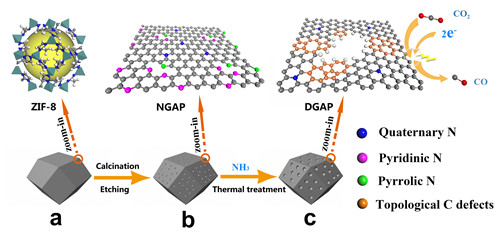Carbon dioxide (CO2) electric reduction technology can use clean electrical energy to convert CO2 into hydrocarbon fuel under mild conditions. While solving the waste of new energy waste due to intermittent problems, it can also alleviate the environmental problems caused by the greenhouse gas CO2. And get high value-added hydrocarbons. The core of the CO2 electric reduction technology is the CO2 reduction reaction (CO2RR) at the cathode, which uses water and CO2 as raw materials to convert at a reduction potential and obtain products such as carbon monoxide, methane, formic acid, methanol, ethylene, ethanol, and acetic acid. However, CO2 has a highly stable chemical structure and is not prone to chemical reactions. It is necessary to develop high-performance CO2RR electrocatalysts to accelerate the reaction. In practical applications, CO2RR electrocatalyst needs to take into account the requirements of catalyst cost, product selectivity, production rate and long-term durability.
Compared with metal-based electrocatalysts, carbon materials have many excellent characteristics, such as abundant reserves, porous structure, stable structure and environmental friendliness. However, the complete carboaromatic ring is chemically inert and difficult to use as a catalytic material. Defect engineering can introduce defects into carbon materials in a targeted manner, break the electronic symmetry in the aromatic ring and adjust the charge density and spin density of carbon atoms, thereby generating catalytically active centers. Topological defects have a locally asymmetric electronic structure, which can adjust the intrinsic catalytic activity of carbon materials. However, due to the higher defect formation energy, it is still difficult to introduce a high concentration of topological defects in carbon materials.
Recently, the team of Chen Liang, a researcher at the Institute of New Energy, Ningbo Institute of Materials Technology and Engineering, Chinese Academy of Sciences, proposed a novel and effective ammonia (NH3) heat treatment strategy to obtain topological defects rich in three-dimensional porous carbon materials (see Figure 1). At lower processing temperatures (<750°C), ammonia heat treatment is usually used to dope the carbon material with nitrogen to obtain a nitrogen-doped carbon material. Chen Liang's team found that increasing the temperature of ammonia heat treatment can induce NH3 to remove the pyrrole-N and pyridine-N doped atoms in N-doped three-dimensional porous carbon materials, which can produce high concentrations of topological defects. Through reaction molecular dynamics simulation, combined with near-edge X-ray absorption fine structure characterization (NEXAFS) and projected state density analysis (LDOS), the researchers found that N atoms in the carbon structure were induced and removed to produce activated low-coordinate carbon The atoms then undergo a local structural rearrangement to produce topological defects such as five-membered rings and 585. As shown in Figure 2, the reaction current density of the three-dimensional porous carbon material rich in topological defects in 0.1M KHCO3 solution with CO2RR reaction potentials at -0.6 and -0.7 V vs. reversible hydrogen electrode (RHE) reached 2.84 mA cm, respectively. -2 and 4.29 mA cm-2, the Faraday efficiency of the CO reactant is as high as 95.2% and 91.9%, respectively, showing excellent CO2RR electrocatalytic activity. In addition, at a reaction potential of -0.6 vs. RHE, after 24 hours of continuous reaction testing, it was found that the Faraday efficiency of carbon monoxide remained above 90%, and the reaction current density did not decrease significantly. The calculation based on density functional theory further confirms that the lowest free energy barrier for CO2RR at the edge of the five-membered ring is the main active center for promoting CO2RR. This research not only provides a new way for defect engineering of carbon materials, but also deepens the in-depth understanding of the mechanism of CO2RR electrocatalysis for carbon defects.
The above work was recently published in the journal Advanced Materials (Adv. Mater. 2020, 2001300) with the title of Ammonia Thermal Treatment toward Topological Defects in Porous Carbon for Enhanced Carbon Dioxide Electroreduction. Doctoral student Dong Yan is the first author, researchers Zhang Qiuju and Tian Ziqi complete the calculation work in the article, and Chen Liang and Su Jianwei are co-corresponding authors. This work was awarded the "From 0 to 1" original innovation project (ZDBSLY-JSC021), the National Natural Science Foundation of China (51872306), the Ningbo Innovation Team Project (2015B11002, 2016B10005), and the Zhejiang Provincial Natural Science Foundation Youth Project (LQ19B030002) and the major project of Ningbo Science and Technology Innovation 2025 (2019B10046). The synchrotron radiation experiment was supported by Yan Wensheng, a researcher at the Hefei National Synchrotron Radiation Laboratory of the University of Science and Technology of China.

Figure 1 Schematic diagram of the synthesis path of three-dimensional porous carbon material rich in topological defects

Figure 2 CO2RR electrocatalytic activity test of three-dimensional porous carbon material rich in topological defects in 0.1 M KHCO3 solution
Finishing Tools
Center Offset Marking Tools,Finishing Tools,Layout Miter Gauge,Cutting Corner Chisel
SHAOXING SUNWAY TOOLS & HARDWARE IMPORT & EXPORT CO.,LTD , https://www.sunwaytools.com